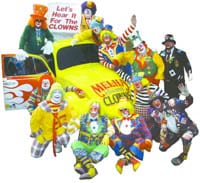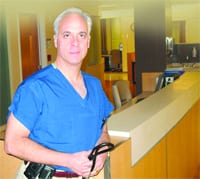Fun with a Purpose Shriner Clowns Know How to Put Their Game Faces On
Jim Allard says that clowns never address themselves by their real names when they’re in uniform, or, as they say in this profession, ‘in face.’
That’s part of the tradition, culture, and code of this pastime, he explained, adding, however, that the habit often spills over to those times that could perhaps best be described as civilian life.
Which could be a problem if your stage name is ‘Nit-Wit.’
But Allard doesn’t mind at all. He told The Healthcare News that his father would affectionately refer to him as ‘nitwit’ when he was a boy, and so he took that name eight years ago when he became a clown for the Melha Shriners. This was not a lifelong dream realized, nor something he probably could have imagined even a decade ago.
But it was something he thought he could do — make that something he must do — out of respect for his daughter and those at Shriners Hospital for Children in Springfield who treated her years ago when she was diagnosed with scoliosis, a lateral curvature of the spine, and never sent a bill.
“She was in a complete body cast for two years; she was allowed out of it for four hours a day,” Allard said of his daughter. “She showed me so much determination … I just felt morally obligated to pay back my debt, and I thought the only way I could do so was to engage in becoming a clown.”
There are many similar stories to be told among the ranks of local Shriner clowns, who are at the forefront of efforts to raise funds for the hospital and other Shrine initiatives. They perform at several dozen events a year, from the annual Melha Shrine Circus to a wide range of fundraisers to drop-in visits to the Springfield hospital, other Shriner facilities, and even local nursing homes to spread some cheer.
The nicknames of the clowns run the gamut — ‘Jinx,’ ‘Shake-N-Bake,’ Fireball,’ ‘Chappy,’ ‘Wingnut,’ ‘Gilligan,’ and ‘Doc’ provide a sampling — as do the professions of those who don the makeup and wear those big shoes, which, says Allard, are sold right here in Springfield, and are actually quite comfortable.
Craig Kazin, a.k.a. ‘Doc’ and the so-called ‘chief clown’ for 2008, is supervisor of Market Analysis for ISO New England, a job he describes as “a stock analyst for the energy business.” Meanwhile, Jim Bradford, or ‘Nolo,’ is a local attorney; John Borowski, ‘Jinx,’ is international manager of specialty markets for Jerr-Dan Corp., the world’s largest maker of towing equipment; Al Suprenant, ‘Poppie,’ is a quasi-retired principal with Suburban Chevrolet in Southwick; and Allard is the second-generation owner of Warren Electrical Contractors.
And while the names on their clown cards (they’re like baseball cards, with a picture on the front and a bio on the back) vary, those carrying the cards have common denominators, specifically passions for clowning and making people, especially children, smile and laugh.
The latter can sometimes be a tall order, said Kazin, especially for young people in Shriners hospitals. He remembers his most difficult assignment personally — a visit to the Shriners Burn Center in Boston — and his recollections speak volumes about how special and sometimes difficult this work is.
“Burns are particularly horrendous and a horrific thing to look at, especially on kids. Usually a nose or an ear is what gets melted off first, so these kids are hard to look at,” he said. “We were mentored on the way over by someone with the Shriners in the Boston area; he told us that what we had to remember was to look past that face and look into the eyes, because for every single kid, there’s a child inside who just wants to play.
“In terms of having to keep your wits about you and control your own feelings on the inside, this was the hardest thing I’ve done as a clown,” he continued, adding that many of his assignments have been similarly challenging. “You have to sometimes hold your heart down in your throat, because everyone has kids, and even if you don’t, compassion for another human being is what it’s all about.”
This month, The Healthcare News goes behind the makeup to examine the art of clowning, and discuss why these businesspeople have a fun time, but consider this very serious work.
Nose for Show Biz
They call it ‘clown school.’
The more formal name is the Northeast Clown Institute, a Plymouth, Mass.-based organization that stages a three-day program on the third weekend of January. Attendance is mandatory for people joining Shriner clown units, and many veterans attend to stay current, teach a class, or just hang out with some like-minded people.
Attendees learn about everything from clown etiquette to applying makeup; from making those balloon animals to the art of comic movement; from juggling to magic.
“It’s a wonderful environment,” said Kazin. “And while there are formalized lectures and breakout sessions, the best stuff is what goes on in the hallways at the hotel; people will cluster off in small groups, and someone will say, ‘let me show you how to do this balloon,’ or ‘isn’t this a really cool magic trick?’”
Bradford has a specific, very important role at the clown institute — teaching attendees how not to get sued.
A Springfield-based attorney and legal counsel for the institute, Bradford told BusinessWest that liability is an issue for everyone these days, and clowns are certainly not immune. They must be careful with those balloon animals — small children can choke on them, and they are made of latex, a material some young people are allergic to — and also with candy, face-painting materials (germs can be spread), and even putting stickers on people.
“I tell them to be practical but not paranoid,” Bradford said of the advice he imparts to fellow clowns. “They just have to be careful.”
The fact that Bradford must give his lecture each year reinforces the notion that clowning isn’t all fun and games.
There are serious commitments of time and money; applying the makeup takes most veterans close to an hour, and there are many expenses. They include makeup, balloons (shrine centers buy most of them, but many clowns have their own supplies), costumes, gas, and those shoes — $400 a pair, says Kazin, noting that they are made of vat-dyed leather and won’t scuff. And there are some occupational hazards, as well; Bradford recalls two hooligans trying to steal his nose and that of a fellow clown at a recent St. Patrick’s Day parade. Meanwhile, Kazin says driving in clown shoes can be hazardous to one’s health and one’s brakes (you can easily hit both pedals simultaneously, so most clowns take the right shoe off when behind the wheel).
And then, there’s the very real fear of clowns among 5{06cf2b9696b159f874511d23dbc893eb1ac83014175ed30550cfff22781411e5} to 10{06cf2b9696b159f874511d23dbc893eb1ac83014175ed30550cfff22781411e5} of the population (the estimates vary), with that percentage being much higher among teenage girls. There are several theories surrounding this, said Kazin, who listed everything from the garish make-up and bright colors to the Stephen King book, later made into a movie, called It, in which a clown-suit-wearing supernatural force named ‘Pennywise’ terrorizes a town in Maine, killing young children.
“Some kids are absolutely terrified of clowns, and you have to be aware of that at all times,” said Borowski. “You have to know how to read people and gauge when to back off and when it’s OK to approach a child; eventually it becomes almost second nature.”
Shriners who choose the clown unit are more than willing to take on all of the above, said Kazin, who, as chief clown — a one-year post that comes after serving in several other officer roles — represents the unit at regular shrine meetings and handles assorted duties, including work to make sure each event is properly staffed.
There are several units within the Melha Shrine, said Kazin, including the popular Hadji, which is comprised of several motorized sub-units, such as go-carts, jeeps, mini-bikes, mopeds, mini-scooters, and tricycles. There’s also the Highlanders (a bagpipe band), a military band, an oriental band, and a ‘vintage autos’ group.
All the units have important roles in fund-raising, he said, adding that the clowns are among the most visible and active of the groups.
There are roughly 80 clowns in the Melha unit, said Kazin, with about two-thirds of them considered active, meaning they attend several dozen events annually. Clowns with the time and the inclination can take part in 100 events or more a year, he continued, adding that the schedule, which may include 150 or more events a year, includes the circus, the annual Pioneer Valley Camping and Outdoor Show at the Big E (a four-day gig), the Winter Festival at Yankee Candle, parades in dozens of communities, and myriad other gatherings large and small.
Surprenant, who has been clowning for a dozen years, is among the most active members of the unit. He was in face “only” 82 times last year, by his count, but has done as many as 135 events, a number he recorded in 2004.
“I was in face every week, and sometimes I’d even do two events in one day,” he said of that year, adding that what motivates such diligence is the reactions from young children. “That’s what brings you out again and again; seeing them laugh and smile is just a powerful reward.”
Big Shoes to Fill
For every clown in the Melha center, there is a story about why they chose the makeup over a kilt and the Highlander Unit.
For some, like Allard, there is a strong, personal connection to one of the Shriners hospitals, such as the Springfield facility, which specializes in orthopedic care, and, like other Shriners hospitals, provides all services free of charge. For most members of this unit, though, there is simply a strong desire to give back, and an inclination, if that’s the right word, to do so through clowning.
And while one undergoes training to be a clown, there must be some natural ability, some talent for making people laugh, as a prerequisite, said Kazin. “If you need the makeup and the costume to be a clown, then you’re not really a clown.”
Kazin said his affinity for humor and clowning stretches back to his youth. “Comedy played a fairly prominent role in my life growing up,” he said. “My father was a salesman, and he was always out with other salesmen, and there were all kinds of jokes that would come back — many of which I wasn’t supposed to hear.”
Like others we spoke with, Kazin said clowning is therapeutic not only for those being entertained, but also those doing the entertaining.
“Clowning allows me to be uninhibited and let my inner self out,” he explained. “I never have a bad time when I’m out clowning; it always puts me a good frame of mind.”
Meanwhile, its also helps him keep things in perspective.
“Sometimes, you’ll be thinking that you’re having a bad day,” he said. “Then, you think of those kids in the hospitals and what they’re going through, and you say to yourself, ‘no, you’re not having a bad day.’”
Allard told The Healthcare News that he finds clowning “addictive,” and that he takes great pride in the uniqueness of his look — buck teeth and freckles — that, along with some zany antics, makes him recognizable and unforgettable.
He puts a lot of time and effort into that look, and for a reason. “The kids are the worst critics … they look you up and down and back and forth. You have to put the effort in and look your best, every time.”
There is an art to clowning, said Allard, noting that, especially with children, the broad assignment is to first make a connection and then generate smiles and laughs. Sometimes, this requires getting down to their level and looking at them eye to eye.
“That takes a little of the edge off,” he explained, adding, as others did, that he gets as much out of his clowning as his audiences do. “Not only do you give to the children, but you get a reward, too; to see their smiling faces and those big eyes, it’s just great. It’s a lot of work, and it’s harder than it looks, but the rewards are phenomenal.”
Clowns get funny looks when they’re parked at red lights when they’re in face, said Allard, and that habit of calling people by their stage names when out of costume can generate similar reactions.
“When you’re out there in public, and you’re calling each other ‘Nit-Wit,’ or ‘Shorty,’ or ‘Choo-Choo,’ people look at you funny and say, ‘what a bunch of goofy guys.’”
Borowski, who took the name ‘Jinx’ as a nod to a drag-racing vehicle he once drove named ‘Li’l Jinx,’ said clowning was a natural progression for him. He once owned a towing company himself and, as a favor to a friend and Shriner clown, housed the Volkswagen used for one of the local unit’s most popular stunts — packing and unpacking as many clowns as possible (usually 17 or 18) into the vehicle. Exposure to the life — and the mission — drew him in.
“I guess I was just destined for this role,” said Borowski, adding that while some of the aspects of clowning are strange or even humbling — shopping for makeup with his daughter falls into that category — it is the notion of ‘having fun for a purpose,’ the unofficial slogan for the Melha Shriners, that resonates with him.
“Every time you put on the makeup, your job is to make a child smile, and there’s nothing more important than great memories in your childhood to round you out as a great adult,” he said. “And that’s exactly why I do it. I do it for the kids.”
Like Kazin and others, Borowski said the visits to the Shriners hospitals comprise some of the most difficult, but also perhaps the most satisfying, work that the clowns do. “It’s just doesn’t seem fair that kids should have to deal with so much pain at that age,” he explained. “If you can make them forget about that pain for just a minute and give you a smile, it’s wonderful, it really is.”
About ‘Face’
Returning to his trip to the burn center, Kazin said the Shriner mentoring his delegation was right on the money with his advice.
“I had a chance to play with a boy from Peru,” he recalled. “He was seriously burned and badly disfigured. When you looked past all that and saw into his eyes, you could see that all he wanted to do was run around and play with us; he was barely conscious of his injuries.
“To bring just a little happiness into that boy’s life, that was …”
He never actually finished the thought. He didn’t have to.
Even a nitwit — and especially the Nit-Wit — could see where he was going, and into the very essence of why Shriners clown.





Comments are closed.